Total War: Shogun 2 – PC Game Review
 Total War: Shogun 2. PC Game Review. Publisher: SEGA. Developer: The Creative Assembly. $49.95
Total War: Shogun 2. PC Game Review. Publisher: SEGA. Developer: The Creative Assembly. $49.95
Passed Inspection: Improved AI, incredible interface in both function and aesthetics, strong overall atmosphere, greater control over the development of leaders and generals, excellent in-game encyclopedia. Avatar Conquest is a great multiplayer addition
Failed Basic: Naval battles might not be as interesting to some after those of Empire: Total War, some AI oddities remain.
Total War: Shogun 2 is more than just a sequel to the first title in the Total War series, it is a reboot that has the potential to take the franchise in an entirely new direction in terms of quality. Visually, the series has always been stunning and has managed to become a graphical showpiece for the next stage of evolution in computer hardware. With the leap in graphics not as comparatively great between the last game and this, one is left to focus on the merits of its gameplay alone. There is less chance for the "wow factor" of the gorgeously animated battles to distract one to overlook the game’s flaws. Add to this the rocky history the series has had in terms of AI, and I came into the game with both excitement and trepidation.
{default}For those new to the series, each Total War title covers a particular period in history and allows the player to choose from a host of factions to control. In this instance it is one nation, Feudal Japan, but players can choose from ten clans (11 with the new downloadable content) that all have different strengths and unique units to field. Gameplay takes place on two levels–a strategic map, where the player must manage their territories and cities and move troops, and a 3D tactical battle mode when armies meet. It is this engrossing combination that has always been the selling point of the series. The ultimate goal in Shogun 2 is to claim the Shogunate of Japan by capturing the capital province of Kyoto as well as a certain number of additional provinces. This number can be adjusted to make for a longer or shorter campaign. The starting position of the various clans means that the player’s choice can make for an easier or more difficult start.
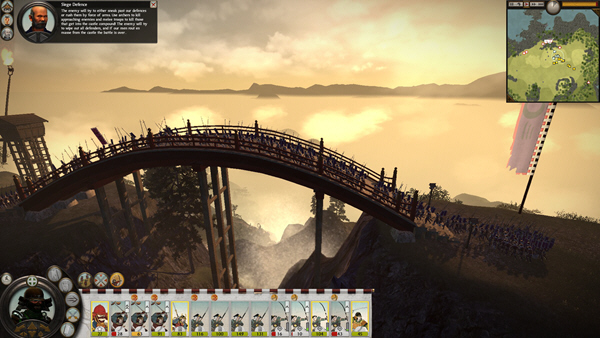
The beauty of Shogun 2’s strategy is that it presents dozens of options as to how to go about defeating your enemies and expanding your control, but limits how much can be accomplished each turn. Your finances are your first obstacle. As one expands their empire, new territories bring the promise of additional taxes as well as upgrades such as better roads or trading posts to earn additional income. But with this comes the need to field larger armies to protect these regions from enemies and internal revolt. Each territory has a propensity to enter into revolt, which is determined by several factors such as armies to oppress the people, high taxes, or food shortages. Other factors that can contribute to the happiness of a region are religion, lowering taxes, and also certain research options that present bonuses.
Furthermore, what can be built in a region depends on how large your castle is and if you have researched the proper technologies. Shogun 2 has a research tree split into two branches, The Way of Chi and Bushido (the civil and military arts, respectively). One can choose to jump back and forth between them or stick to one, but either way the choices to be made are numerous, from the capability to use fire arrows to the building of Shinobi schools to aid in the use of subterfuge.
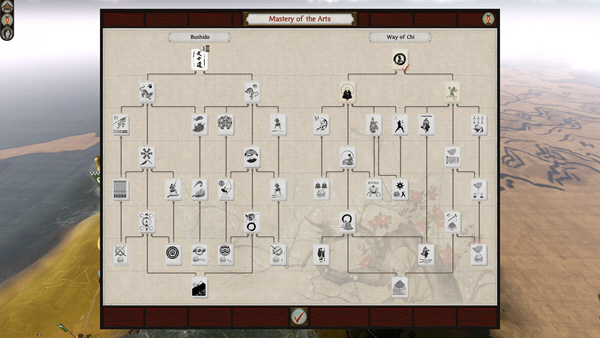
Shogun 2 includes all of the best features that have been added to the series over the years, but the smaller, more intimate scope of the game means things are more streamlined and accessible. For instance, the prior games in the series, Empire and Napoleon, added elements such as naval battles and overseas trade routes. The expanse of the map in Empire, however–covering all of Western and Central Europe, part of Africa, India, North America and the Caribbean–meant that managing and keeping track of everything was a much larger proposition.
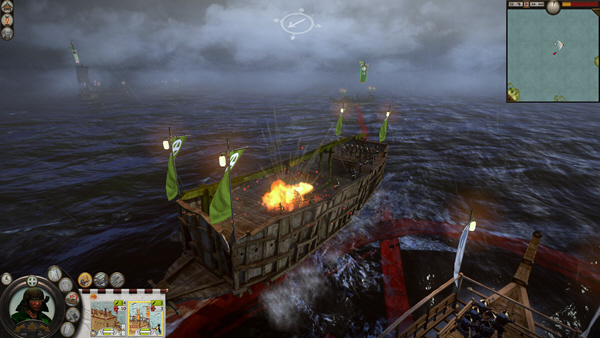
Seaborne trade routes are present, but are easier to manage or blockade if they belong to the enemy. In particular areas of the map one can also set up trade routes with other nations such as China and Europe, allowing the importation of money making trade goods or primitive, though highly effective, firearms and artillery. Naval combat makes a return, and although this era is less famous for its sea battles than the Age of Sail, trading massive, cannon-bearing frigates and ships of the line for vessels armed with troops shooting arrows or firebombs is surprisingly enjoyable (one can also borrow some frigates from the Europeans as well). Ships can be boarded and captured to swell one’s ranks, and a fleet is imperative to maneuvering armies around the campaign map for surprise attacks or to avoid the inevitable chokepoints on the map one when one encounters a sprawling rival clan.
Earlier titles introduced the dynamic of a family tree. Your leader, in this case the daimyo, can be used to lead troops on the battlefield. In addition, they will occasionally have children, which can be chosen to be successor should the daimyo fall in battle. The emphasis on male lineage means it is important to keep at least one alive to eventually become Shogun. Children can enter into marriages between clans to cement relations or even be kidnapped and ransomed. In prior titles, family members and generals would automatically gain traits over time that would affect their abilities in battle. This time around, units gain experience and the player can then choose how to upgrade their units, meaning greater customization. This RPG lite feature adds a tremendous amount of personal attachment to your generals and leaders as you dictate their path and specialize their roles in your burgeoning empire. Generals can now desert, however, based on their loyalty, which is in turn affected by the daimyo’s honor, which can be lowered by losing battles, breaking treaties, sacking castles, or even letting a losing general continue to live. This, coupled with dilemmas that pop up every now and then, forcing the player to make a decision that can affect their clan one way or the other, lends a dynamic to each game.
Of course, the feature most players will welcome is the return of the Ninja (not to be outdone by his sister in subterfuge, the Geisha). These spymasters and assassins of Feudal Japan have a long and storied history, sometimes becoming powerful enough to challenge the very daimyos they served. They are powerful when used properly, able to kill enemy generals, delay the movement of an army, or open the gates of enemy strongholds before attacking. Each province that is capable of training Ninjas can only build one, however, which ensures their power can’t be abused. Other special agents as well, such as Geisha, are no longer generated as in prior games, but must be recruited. The success of their missions is presented through beautifully animated cinematics that perfectly capture the flavor of ninja lore.

Battles play out in the same fashion as previous Total War titles, but there are a few new additions that add to the tactical value. Adverse weather has a greater effect on battles, degrading the effectiveness of missile units. Taking advantage of the terrain in battles has always been important, but one of the great new features is that the terrain, rather than being randomly chosen, is based on the province where the enemy armies meet. Siege battles are also greatly improved, and according to the manual, due to historical reasons. Due to the region being prone to earthquakes, fortresses were built raised on stone ramparts. This allows any of your troops to climb this and get over the walls. Some troops will inevitably fall, and those that make it have to survive long enough for their comrades to push back the enemy, but I found the process to be much improved, and the AI capable of defending against and performing sieges.
The game boasts many historical units that fit into the infantry, cavalry, and archer dynamic of this era of warfare. Interestingly, cavalry can now dismount from their steeds to join in a siege. The main backbone of one’s army, however, is the samurai, which is pricey to build but unmatched on the field. Historically based scenarios can also be played outside of the campaign, as the game contains a handful of historical battles and a full custom battle mode.
To keep track of all the game’s buildings, units, and technologies, there is an elegant encyclopedia that can be accessed from the main menu, or in-game similar to the way the Civlopedia for the Civilization series works. At no point was I struggling to understand any of the game’s concepts. As is traditional in the series, in-game help can be turned on or off and it offers great advice and has excellent voice acting. There is also a full tutorial campaign that walks the player through all the important elements of the game.
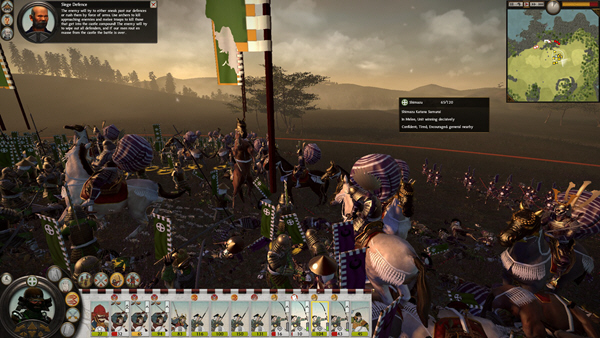
The highlight of this entry to the series, however, is the amazingly beautiful interface. Never have I seen functionality so enmeshed with aesthetic beauty. When one clicks on an army or territory, everything needed to manage it is presented along the bottom of the screen. Icons on the side give access to all the major components of the game such as research, diplomacy, and family history — pretty standard fare for a strategy game. But what the designers have done is captured an almost natural beauty in how everything is laid out. There is no clutter or wasted space, and even the icons for units and family portraits are in the style of traditional Japanese paintings that help create a sense of period many games try to capture but rarely achieve with such aplomb. Colorful loading screens in the vein of traditional screen door paintings depict scenes of nature and the elements. The rise of this art form was an attempt to capture peace and serenity in a time of chaos and war, and so gives the game’s graphics a historical relevance.
This transfers to other elements of the game’s graphics as well. The fog of war on the campaign map is presented as a sketch of the surrounding terrain in the style of inks on parchment. As the seasons change, hauntingly beautiful storm clouds cover mountain ranges or flashes of pink across the screen give the fleeting sense of cherry blossoms shedding their leaves.
The game also boasts a terrific soundtrack, something it shares with the original Shogun. In fact, I instantly recognized one of the tracks that was reused for this title, even thought I haven’t played the original for years. It is very distinct and complements the game’s art direction perfectly. Similarly, the sound effects are outstanding, with terrific accented voice acting and attention to detail – especially in battle mode. Every footstep, whiz of an arrow, or creaking of a ship is accounted for and adds immeasurably to the fun of playing the battles.
It must also be noted that the developers have been good so far with patching the game, and downloadable content has also been released that adds an additional playable clan, the Ikko Ikki, which is a fanatical religious clan that boasts warrior nuns.
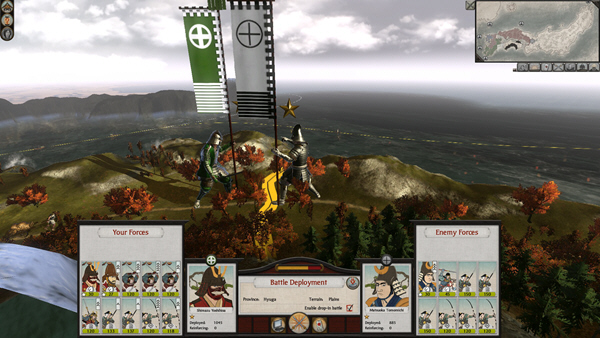
My biggest gripe with prior entries in the series has been with the AI, which even after expansion packs and a lot of patching, still played a weak, sometimes nonsensical game. Armies would shuffle around or wander for no apparent reason, and diplomatic agreements were tenuous at best–often broken or not honored properly. I’m happy to say that while Shogun 2’s AI is not going to match the wiliness of a human opponent, my experience with it was very satisfying. I played the campaign on the Hard difficulty level and the enemy was more than capable of expanding, fielding large armies that protected their regions, and entering into sensible diplomatic agreements that stuck much better than before (also diplomatic relations are much easier to gauge due to the leaders being shown in animated videos which clue the player in on their current feelings toward your clan). Enemy armies will also pursue you if you are defeated, making retreat from enemy territory that much harder and the decision to enter into battle must be carefully considered. I have read on forums that the AI does get some bonuses, especially on harder difficulties, but the underworking logic of the AI is still much improved. The battle AI has also been strengthened. It is vastly more capable of handling a siege, often breaking up their army to attack weak parts of the walls or distract. I did notice some of the issues that have always come up in the Total War titles, such as unprotected generals. So while not perfect, the AI is capable of making for an entertaining, challenging game.
Though I opt to play grand strategy games single player, there are multiplayer options. Players can join a competitive or cooperative campaign, opting to play out battles or have them autoresolved. A great addition to the single-player campaign allows the player to have other online players drop into battles to control the enemy. Since one will never know just how skilled they are beforehand, it does add a realistic, unpredictable element to battles. If one opts to enable this feature, the player may also be asked to fight a battle during the course of the campaign, at which point the game saves its progress and transitions to the battle.
The most attractive multiplayer addition for me was Avatar Conquest. Due to the time it takes to play a campaign, this offers a great alternative in that it allows the player to engage in multiplayer battles with more depth and a sense of progress. First the player creates an avatar, whose appearance, armor, and skills can be customized in addition to army and navy composition. As the avatar is moved to different provinces, the player can have an online battle automatically matched with a player of similar skill level, or the player can join from a list of battles set up by other players. Win or lose, the player’s avatar will gain experience, which will unlock new armor sets as well as allow for the upgrading of skills. Winning a battle, however, allows you to reap the bonuses of the respective province, which unlocks new units to add to armies or navies as well as additional bonuses. This creates a situation where players can gradually improve their chances of winning battles as well as challenge stronger competitors. Through Steam, players can also join or start a clan, and victories contribute to that clan’s dominance. I hope this becomes a staple of the series, as it is a great compromise between playing long online campaigns and ultimately meaningless online battles. It is also a great way to develop battle strategies, as the player gets the chance to fight an array of opponents with different army makeups.
Total War: Shogun 2 is vastly improved over earlier iterations of the series. It takes all of the best elements and expands or streamlines them to provide a great gameplay experience. Word has already come out that the developers are working on the next title in the series. It will be interesting to see if the developers can maintain the improved AI and effortless interface when dealing with a larger theatre. Whether they choose to revisit the birth of Rome, the stone ramparts of Medieval Europe, or an entirely new period, I am once again excited to wage total war.
Armchair General Score: 90%
![]()

